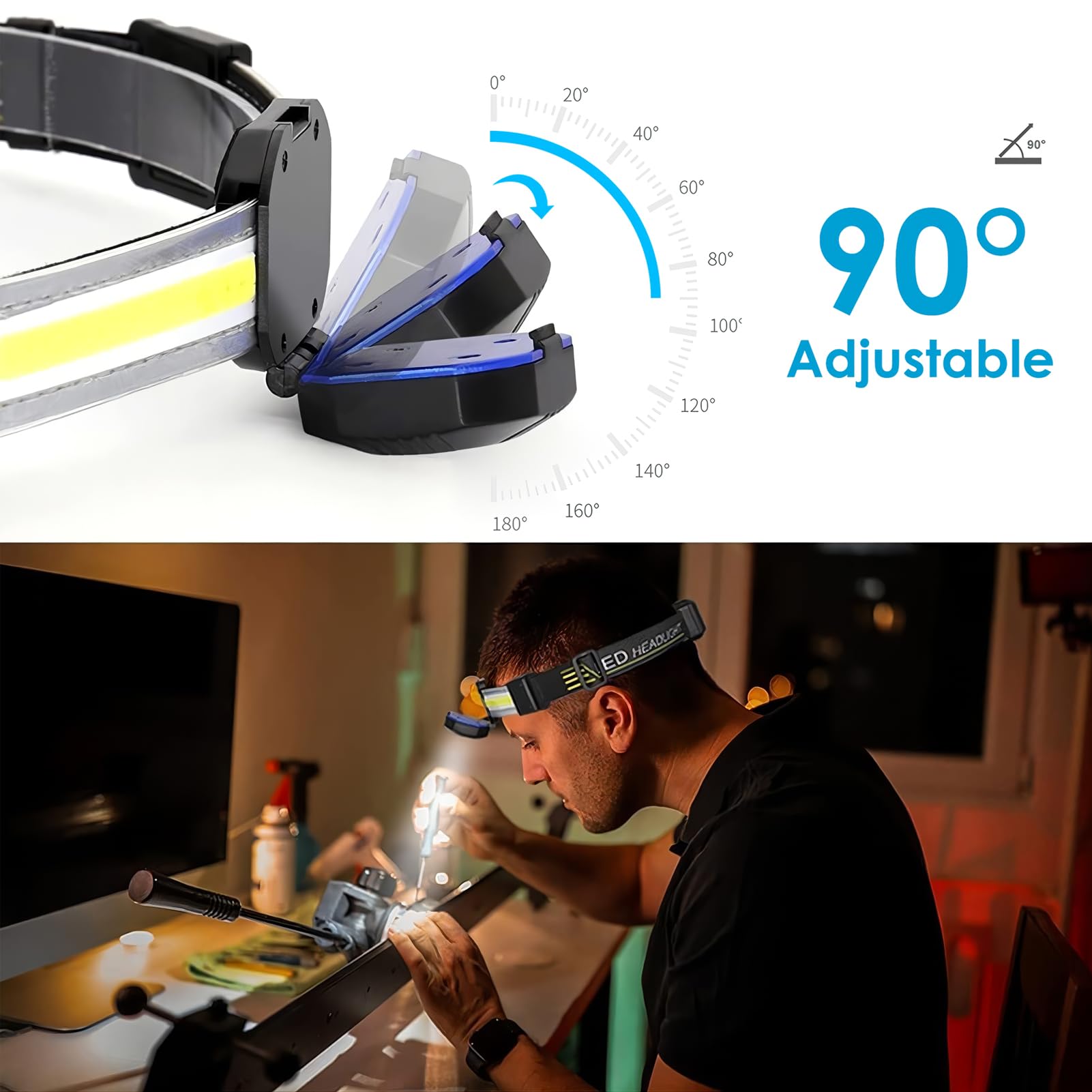A wide-beam headlamp, also known as a flood light or area light, is a type of portable lighting device designed to provide a broad, diffused beam of light over a wide area. Unlike traditional headlamps or flashlights that produce a focused, concentrated beam, wide-beam headlamps emit a broader, more dispersed illumination pattern, making them ideal for tasks that require illuminating a larger area or workspace.
The primary purpose of a wide-beam headlamp is to provide ample lighting coverage for activities where you need to see a wide field of view or illuminate a larger area simultaneously. These headlamps are particularly useful for camping, hiking, outdoor work, construction, search and rescue operations, and any situation where you need to light up a broader area while keeping your hands free.
Wide-beam headlamps typically feature a lightweight and compact design, with the light source mounted on an adjustable headband or strap, allowing for hands-free operation. They often incorporate multiple light modes, such as a wide flood beam, a focused spot beam, and sometimes even a red light mode for preserving night vision. The light source can be powered by batteries, rechargeable batteries, or even solar panels, depending on the model.
Table of Contents
Benefits of Wide-Beam Headlamps
Wide-beam headlamps offer several key benefits over traditional headlamps with a narrower beam pattern. Improved visibility is perhaps the most significant advantage, as these lamps project a wider, more dispersed light that illuminates a larger area in front of the user. This expanded field of view enhances situational awareness, allowing users to better perceive their surroundings, obstacles, and potential hazards.
Safety is another critical benefit of wide-beam headlamps. By providing a broader illumination area, these lamps reduce the risk of tripping or colliding with unseen objects, making them ideal for outdoor activities like hiking, camping, or working in low-light conditions. The increased visibility also helps users navigate terrain more confidently, reducing the likelihood of accidents or injuries.
Convenience is another notable advantage of wide-beam headlamps. With their ability to cast light over a larger area, users can perform tasks more efficiently without constantly adjusting their position or the direction of the light beam. This hands-free operation allows for greater freedom of movement and improved productivity, whether you’re setting up a campsite, working on a project, or engaging in outdoor pursuits.
How Wide-Beam Headlamps Work
Wide-beam headlamps are designed to provide a broad, evenly distributed beam of light, illuminating a larger area than traditional focused headlamps. This is achieved through a combination of optical design, lens technology, and carefully engineered beam patterns.
Optical Design
The optical design of wide-beam headlamps involves the use of specialized reflectors or lenses that shape and distribute the light from the bulb or LED source. Instead of concentrating the light into a narrow, focused beam, these optics are engineered to spread the light over a wider angle, creating a broad, diffused beam pattern.
Lens Technology
Wide-beam headlamps often employ advanced lens technologies to further enhance the beam distribution. Fresnel lenses, which are thin and lightweight yet highly efficient, are commonly used. These lenses feature concentric grooves that refract and spread the light, creating a wide, uniform beam pattern. Additionally, some wide-beam headlamps incorporate diffuser lenses or specialized coatings to further soften and evenly distribute the light.
Beam Pattern
The beam pattern of wide-beam headlamps is carefully engineered to provide optimal illumination for various scenarios. Instead of a concentrated spot, the beam pattern is designed to be wide and evenly distributed, creating a broad pool of light that illuminates a larger area. This beam pattern is particularly useful for activities like camping, hiking, or working in close proximity, where a wide, even illumination is preferred over a focused beam.
Types of Wide-Beam Headlamps
Wide-beam headlamps are available in different types, each with its own set of features and advantages. The most common types are LED, halogen, and HID (High-Intensity Discharge) lamps.
LED (Light-Emitting Diode) Headlamps
LED headlamps are becoming increasingly popular due to their energy efficiency, long lifespan, and bright, focused beam. They are typically more expensive than traditional bulbs but offer several benefits:
- High lumen output with low power consumption
- Instant-on capability, no warm-up time required
- Durable and shock-resistant
- Long lifespan (up to 50,000 hours)
- Consistent light output throughout their lifespan
LED headlamps are available in various beam patterns, including spot, flood, and combination beams, making them suitable for a wide range of activities.
Halogen Headlamps
Halogen headlamps are a traditional choice and are known for their affordability and decent light output. They work by passing an electric current through a tungsten filament, which heats up and produces light. Halogen headlamps offer:
- Relatively bright light output
- Affordable and widely available
- Warm, yellowish light color
- Shorter lifespan compared to LED (around 1,000 hours)
- Fragile filament, susceptible to shock and vibration
Halogen headlamps are a cost-effective option for those on a budget, but they may require more frequent bulb replacements and consume more power than LED alternatives.
HID (High-Intensity Discharge) Headlamps
HID headlamps are known for their intense, bluish-white light output and long-range visibility. They work by creating an electric arc between two electrodes in a sealed capsule filled with xenon gas. HID headlamps offer:
- Extremely bright and focused light beam
- Long lifespan (up to 10,000 hours)
- Excellent color rendering and visibility
- Instant restart capability (no warm-up time)
- More expensive than halogen and some LED options
HID headlamps are popular among outdoor enthusiasts, construction workers, and anyone who requires a powerful, long-range light source. However, they can be more expensive and may require specialized ballasts or power supplies.
When choosing a wide-beam headlamp, consider factors such as brightness, beam pattern, battery life, durability, and intended use. LED headlamps offer the best combination of performance, efficiency, and longevity, while halogen and HID options may be suitable for specific applications or budgets.
Choosing the Right Wide-Beam Headlamp
When selecting a wide-beam headlamp, several factors should be considered to ensure you get the best product for your specific needs. Brightness, measured in lumens, is a crucial factor as it determines how much light the headlamp will emit. For most outdoor activities, a brightness range of 200-400 lumens is sufficient, but if you need to illuminate larger areas or have specific requirements, higher lumen outputs may be necessary.
Beam pattern is another important consideration. Wide-beam headlamps offer a broader, more dispersed light pattern, making them ideal for tasks that require illuminating a larger area, such as camping, hiking, or working on projects. However, if you need a more focused beam for activities like trail running or reading, a headlamp with a spotlight mode or a narrower beam pattern may be more suitable.
Runtime, or battery life, is also crucial, especially for extended outdoor activities or emergency situations. Look for headlamps with energy-efficient LED bulbs and rechargeable or long-lasting battery options. Some headlamps even offer different brightness modes, allowing you to conserve battery life by adjusting the light output as needed.
Weight and comfort are additional factors to consider, especially if you plan to wear the headlamp for extended periods. Lightweight and well-balanced designs with adjustable headbands can help prevent fatigue and ensure a secure, comfortable fit.
Finally, consider any additional features that may be useful for your specific needs, such as waterproofing, impact resistance, or the ability to use different types of batteries. Some headlamps also offer additional lighting modes, like flashing or strobe, which can be useful for signaling or visibility in certain situations.
Installation and Use
Wide-beam headlamps are designed for easy installation and hassle-free use. Most models come with adjustable headbands or clips that allow you to securely mount the lamp on your head, helmet, or cap. The adjustability ensures a comfortable and secure fit, preventing the lamp from slipping or bouncing during physical activity.
Proper beam adjustment is crucial for maximizing the effectiveness of your wide-beam headlamp. Many models feature tilt mechanisms that allow you to angle the beam precisely where you need it, whether you’re illuminating a close-up work area or lighting up a distant trail. Some advanced models even offer multiple beam patterns, allowing you to switch between a wide flood beam for up-close tasks and a focused spot beam for long-range visibility.
Runtime and battery life are important considerations when choosing a wide-beam headlamp. High-quality lamps typically use energy-efficient LED bulbs and offer various power modes, enabling you to balance brightness and battery life based on your needs. Runtimes can range from a few hours on the highest setting to several days on the lowest setting, depending on the battery capacity and power management features.
Many wide-beam headlamps are powered by rechargeable batteries, which can be easily recharged via USB or other charging methods. This convenient feature eliminates the need for disposable batteries and reduces environmental impact. Some models even offer battery level indicators, so you can monitor the remaining charge and plan accordingly.
Popular Wide-Beam Headlamp Brands
When it comes to wide-beam headlamps, several brands stand out for their quality, innovation, and performance. Here’s an overview of some of the most popular and respected wide-beam headlamp brands:
Black Diamond
Black Diamond is a leading name in the outdoor gear industry, and their wide-beam headlamps are no exception. They offer a range of models designed for various activities, from camping and hiking to climbing and trail running. Black Diamond headlamps are known for their bright, evenly distributed beams, durable construction, and user-friendly features.
Petzl
Petzl is a French company that has been at the forefront of outdoor equipment design for decades. Their wide-beam headlamps are favored by professionals and enthusiasts alike for their reliable performance and innovative technologies. Petzl’s offerings include models specifically designed for activities like caving, climbing, and search and rescue operations.
Fenix
Fenix is a respected brand in the world of high-performance lighting solutions, and their wide-beam headlamps are a testament to their expertise. Known for their exceptional brightness and long runtimes, Fenix headlamps are popular among outdoor enthusiasts, emergency responders, and industrial professionals.
Nitecore
Nitecore is a relatively newer brand but has quickly gained a reputation for producing high-quality, feature-rich wide-beam headlamps. Their models often incorporate advanced technologies like USB charging, multiple beam patterns, and intelligent brightness adjustment, catering to a wide range of user needs.
Coast
Coast is an American company that specializes in portable lighting solutions, including a selection of wide-beam headlamps. Their headlamps are praised for their affordability, durability, and versatility, making them a popular choice for recreational and professional use.
These brands offer a wide range of wide-beam headlamp models, each with its own unique features and strengths. When choosing a wide-beam headlamp, it’s essential to consider factors such as intended use, brightness, battery life, and overall build quality to ensure you select the best option for your needs.
Wide-Beam Headlamps for Specific Activities
Wide-beam headlamps are versatile lighting solutions that cater to a range of outdoor activities, each with its unique requirements. Whether you’re an avid hiker, a seasoned camper, an intrepid caver, or a cycling enthusiast, there are wide-beam headlamps designed specifically to enhance your experience and ensure optimal visibility.
Hiking and Camping
For hikers and campers, wide-beam headlamps offer a broad illumination area, allowing you to navigate trails, set up camp, and perform various tasks with ease. These headlamps typically feature a combination of flood and spot modes, enabling you to switch between a wide, diffused beam for up-close tasks and a focused beam for distance viewing. Many hiking and camping-specific models are lightweight, water-resistant, and offer extended battery life to keep you illuminated during multi-day adventures.
Caving
Caving requires a headlamp with exceptional brightness and beam distance to navigate the dark, often narrow passages of caves. Wide-beam caving headlamps boast high lumen outputs and powerful spot beams that can reach hundreds of meters, ensuring you can see obstacles and navigate safely. These headlamps are also designed to be durable, water-resistant, and often feature additional safety features like backup lighting or emergency strobe modes.
Cycling
For cyclists, a wide-beam headlamp can be a game-changer, providing ample illumination for night rides or low-light conditions. Cycling-specific models often feature a wide, even beam pattern that illuminates the path ahead without creating glare or blinding oncoming traffic. These headlamps are designed to be lightweight, aerodynamic, and securely mounted to your helmet or handlebars, ensuring hands-free operation and consistent visibility.
Other Activities
Wide-beam headlamps also cater to various other activities, such as fishing, hunting, search and rescue operations, and even industrial or professional applications. Fishing headlamps may offer red or green light modes to preserve night vision, while hunting headlamps prioritize long-range spot beams for spotting game. Search and rescue models prioritize durability, brightness, and long battery life, while industrial headlamps often meet specific safety and certification standards.
Regardless of your chosen activity, there is a wide-beam headlamp tailored to meet your specific needs, ensuring you have the right lighting solution to enhance your outdoor adventures or professional tasks.
Care and Maintenance
Proper care and maintenance are essential to ensure your wide-beam headlamp continues to perform optimally and has a long lifespan. Here are some tips for cleaning, storage, battery replacement, and troubleshooting:
Cleaning: Wide-beam headlamps are often exposed to dirt, sweat, and other elements during outdoor activities. Regular cleaning can prevent buildup and ensure optimal light output. Use a soft, damp cloth to wipe down the exterior of the headlamp, taking care not to submerge it in water. For stubborn dirt or grime, use a mild soap and water solution. Avoid harsh chemicals or abrasives, as they can damage the lens or housing.
Storage: When not in use, store your wide-beam headlamp in a cool, dry place, away from direct sunlight or extreme temperatures. Remove the batteries during long-term storage to prevent leakage, which can damage the headlamp’s internal components. Consider storing the headlamp in a protective case or pouch to prevent scratches or damage.
Battery Replacement: Wide-beam headlamps typically use disposable or rechargeable batteries. Follow the manufacturer’s instructions for proper battery installation and replacement. Use high-quality batteries from reputable brands for optimal performance and longevity. Always replace all batteries at the same time to ensure consistent power output.
Troubleshooting: If your wide-beam headlamp is not functioning properly, try the following troubleshooting steps:
- Check the batteries: Ensure they are properly installed and have sufficient charge.
- Clean the contacts: Use a clean, dry cloth to gently wipe the battery contacts and the headlamp’s contact points.
- Inspect the headlamp: Look for any visible damage, such as cracks or water ingress, which may require repair or replacement.
- Consult the manual: Refer to the manufacturer’s instructions for specific troubleshooting guidance or contact their customer support if the issue persists.
By following these care and maintenance tips, you can extend the lifespan of your wide-beam headlamp and ensure it remains a reliable and high-performing lighting solution for all your outdoor adventures.
Future of Wide-Beam Headlamp Technology
The future of wide-beam headlamp technology is exciting, with several emerging technologies and innovations on the horizon. One of the most promising developments is the integration of advanced optics and lens systems that can further enhance the beam pattern and light distribution. Manufacturers are exploring the use of precision-engineered reflectors and lenses to create even wider and more uniform beams, improving visibility and reducing blind spots.
Another area of innovation is the incorporation of adaptive lighting systems. These intelligent systems can automatically adjust the beam pattern and intensity based on various factors, such as ambient light conditions, terrain, and the presence of other vehicles or pedestrians. This dynamic adjustment can significantly improve safety and visibility in different environments.
The integration of smart connectivity features is also gaining traction in the wide-beam headlamp market. Some manufacturers are exploring the possibility of connecting headlamps to smartphones or other devices, allowing users to control and customize settings, monitor battery life, and even receive firmware updates wirelessly.
Energy efficiency is a significant consideration in the development of future wide-beam headlamps. Advancements in LED technology and battery management systems are enabling longer runtimes and reduced power consumption, making wide-beam headlamps more eco-friendly and cost-effective in the long run.
Additionally, the industry is exploring the use of alternative power sources, such as solar panels or kinetic energy harvesting, to extend the battery life of wide-beam headlamps. These innovative solutions could potentially eliminate the need for disposable batteries, further reducing the environmental impact of these devices.
Overall, the future of wide-beam headlamp technology promises to deliver enhanced performance, increased versatility, and improved user experiences. As manufacturers continue to push the boundaries of innovation, we can expect to see even more advanced and feature-rich wide-beam headlamps hitting the market in the years to come.



